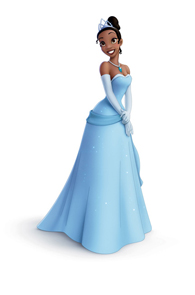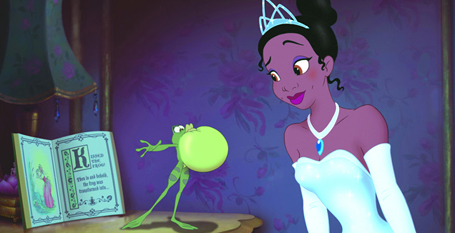
I have tremendous respect for the studio that Walt Disney has created, and its pioneer status in the art and science of animation. But there’s the other Disney studio, the one which ran out of artistic direction and money in the 1970s (With Robin Hood recycling dance sequences and designs from earlier Disney pics!), killed its own late 1980s resurgence with straight-to-video sequels, and then rolled over and played dead in the face of the 3D animation wave shortly after.
But really, it was never about how 2D animation was “dead” or that its time was over. For animated film, it’s always about the storytelling and the visual spectacle that conjures up imagination. We’re happy to report that Princess and the frog, as Disney’s first hand-drawn, 2D animation in years, does not have a script that relies on the inane “One pop culture reference a minute” metric that its lesser competitors resort to.
The pic is a very traditional retouching of the Brothers Grimm folk tale, with the locale transported to New Orleans, some time in the Jazz Age of the 1920s. I’m sure the inauguration of Barack Obama had something to do with the casting of the Princess as a hard working African-American waitress, but this time round, it doesn’t feel like a gimmick at all. The look and feel of New Orleans and the sounds of different forms of jazz and gospel music pulse through the film, making it very much alive in a way Disney cartoons haven’t been in a long time.
Visually, the animation is ambitious – a mix between Disney’s classical style from its Lady and the Tramp golden era, and a trippy mix of experimental styles that bring to mind obscure “arty” East European, Russian animations as well as Pixar’s ending credit animation styles. If there’s anything Princess and the frog achieves, it’s a convincing demonstration that 2D animation is where the imagination lies, where the animator and audience are freed from representing the real and the realistic.
Story-wise, the picture is very entertaining, sufficiently solid, moderately creative in its reinterpretation of the original folk tale, and hits all the right spots in its “moral of the story” department. It is though, very strangely devoid of politics of the real world or even of the period in which it is set – but I suppose we are after all in the post-racial era, where these issues no longer matter any more.












 Printable Version
Printable Version










Reader's Comments
Not only does the cartoon look like Michelle, but the story follows the pattern: turning an insignificant nobody, an uprooted wanderer through 3 continents whose place of birth, changes of nationality and the actual nationality etc. remain unclear into an acceptable leader of a nation with most nuclear armament, the Nobel "Peace" Prize winner who escalates wars?
Hmmm...
Please log in to use this feature.